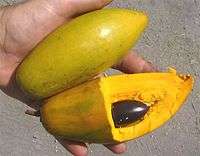Sapote
Sapote (from Nahuatl tzapotl)[1] is a term for a soft, edible fruit. The word is incorporated into the common names of several unrelated fruit-bearing plants native to Mexico, Central America and northern parts of South America.
Some but not all sapotes come from the family Sapotaceae:
- Sapotaceae sapotes:
- Sapodilla, also called naseberry (Manilkara zapota) is native to Mexico, Guatemala, Nicaragua, Belize, and possibly El Salvador. The Sapotaceae were named after a synonym of this species.
- Yellow sapote (Pouteria campechiana) is native to Mexico and Central America.
- Mamey sapote (Pouteria sapota) is from southern Mexico to northern South America.
- Green sapote (Pouteria viridis) is native to lowland southern Mexico.
- Ebenaceae sapotes:
- Black sapote (Diospyros nigra), from eastern Mexico south to Colombia, is probably the original Aztec tzapotl.
- Chapote (Diospyros texana) is native to the lower Rio Grande valley region in Texas and Mexico
- Other sapotes
- White sapote (Casimiroa edulis: Rutaceae) is native to northern and central Mexico, Costa Rica, El Salvador and Guatemala.[2]
- South American sapote (Quararibea cordata: Malvaceae) is native to the Amazon rainforests of Brazil, Colombia, Ecuador, and Peru.
-
Lòng mứt, a kind of Vietnamese sapote
References
- ↑ Watson, George (April 1938). "Nahuatl Words in American English". American Speech. 13 (2): 113–114. JSTOR 451954.
- ↑ "Casimiroa edulis". Germplasm Resources Information Network. United States Department of Agriculture. Retrieved 2009-03-26.
This article is issued from Wikipedia - version of the 3/17/2016. The text is available under the Creative Commons Attribution/Share Alike but additional terms may apply for the media files.






